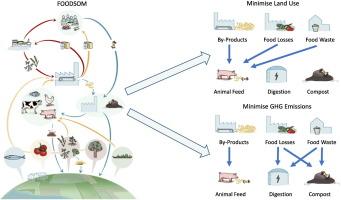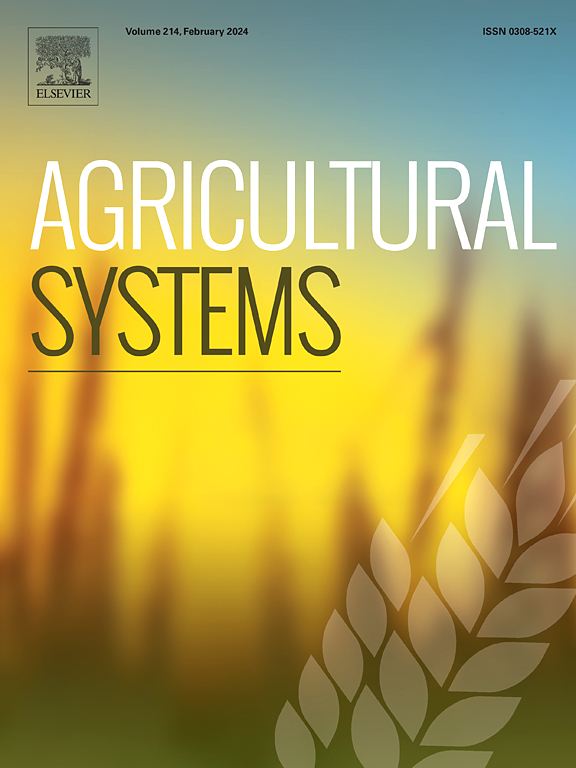How to use residual biomass streams in circular food systems to minimise land use or GHG emissions
IF 6.1
1区 农林科学
Q1 AGRICULTURE, MULTIDISCIPLINARY
引用次数: 0
Abstract
Context
Transitioning to future circular economies and food systems will increase demand for biomass in society. Residual streams, which include food loss, food waste and by-products (e.g., rapeseed meal) from agriculture and food production are a valuable source of biomass in more circular food systems. It is currently unclear if and whether these residual streams should be utilised optimally: as animal feed, composted as organic fertiliser or for anaerobic digestion to produce biogas (methane) and digestate (fertiliser) to minimise environmental impacts from food systems.
Objective
Our aim is to understand which residual streams are to be utilised as animal feed, compost or for anaerobic digestion in circular food systems to achieve minimum agricultural land use and greenhouse gas (GHG) emissions under scenarios with different dietary preferences.
Methods
Taking the Netherlands as a case study, we employed the FOODSOM model, an iterative linear optimisation model of a circular food system in the Netherlands. FOODSOM minimises agricultural land use or GHG emissions while meeting the dietary requirements of the population. Four scenarios based on two different human diets and two food system objectives (i.e., minimise land use or GHG emissions) were developed.
Results & conclusions
Our results show by-products should be fed to livestock when aiming to minimise agricultural land use and GHG emissions, food loss and waste is best fed to livestock when minimising land use, but composted or digested when minimising GHG emissions. The decision to compost or digest food waste depends on whether the GHG emissions from anaerobic digestion are assigned to the food system or the biogas (methane) produced.
Significance
Our results provide guidance on how residual streams, including food loss, food waste and by-products can be optimally utilised in future circular food systems to achieve minimal agricultural land use and GHG emissions when meeting dietary requirements.

如何在循环食品系统中利用剩余生物质流,最大限度地减少土地使用或温室气体排放
背景向未来循环经济和粮食系统的过渡将增加社会对生物质的需求。农业和食品生产中的残余物,包括食物损失、食物垃圾和副产品(如菜籽粕),是更多循环型食品系统中宝贵的生物质来源。目前还不清楚这些残余物是否应得到最佳利用:作为动物饲料、堆肥作为有机肥料或进行厌氧消化以产生沼气(甲烷)和沼渣(肥料),从而最大限度地减少粮食系统对环境的影响。目标我们的目的是了解在循环食品系统中,哪些残留物流可用作动物饲料、堆肥或厌氧消化,以在不同饮食偏好的情况下实现农业用地利用和温室气体(GHG)排放最小化。FOODSOM 在满足人们饮食需求的同时,最大限度地减少了农业用地的使用或温室气体的排放。我们的研究结果表明,在尽量减少农业用地和温室气体排放的情况下,应将副产品喂养牲畜;在尽量减少土地使用的情况下,最好将食物损失和浪费喂养牲畜;在尽量减少温室气体排放的情况下,最好对食物进行堆肥或消化。决定堆肥还是消化食物垃圾取决于厌氧消化产生的温室气体排放是分配给食品系统还是产生的沼气(甲烷)。意义我们的研究结果为如何在未来的循环食品系统中优化利用残留物流(包括食物损失、食物垃圾和副产品)提供了指导,以便在满足饮食要求的同时实现最小的农业用地使用和温室气体排放。
本文章由计算机程序翻译,如有差异,请以英文原文为准。
求助全文
约1分钟内获得全文
求助全文
来源期刊

Agricultural Systems
农林科学-农业综合
CiteScore
13.30
自引率
7.60%
发文量
174
审稿时长
30 days
期刊介绍:
Agricultural Systems is an international journal that deals with interactions - among the components of agricultural systems, among hierarchical levels of agricultural systems, between agricultural and other land use systems, and between agricultural systems and their natural, social and economic environments.
The scope includes the development and application of systems analysis methodologies in the following areas:
Systems approaches in the sustainable intensification of agriculture; pathways for sustainable intensification; crop-livestock integration; farm-level resource allocation; quantification of benefits and trade-offs at farm to landscape levels; integrative, participatory and dynamic modelling approaches for qualitative and quantitative assessments of agricultural systems and decision making;
The interactions between agricultural and non-agricultural landscapes; the multiple services of agricultural systems; food security and the environment;
Global change and adaptation science; transformational adaptations as driven by changes in climate, policy, values and attitudes influencing the design of farming systems;
Development and application of farming systems design tools and methods for impact, scenario and case study analysis; managing the complexities of dynamic agricultural systems; innovation systems and multi stakeholder arrangements that support or promote change and (or) inform policy decisions.
 求助内容:
求助内容: 应助结果提醒方式:
应助结果提醒方式:


